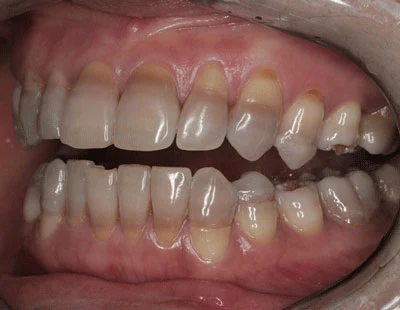Dental Hypoplasia Caused By Tetracycline

Dental Hypoplasia: Causes, Impacts, and Treatment
Dental hypoplasia, a pathological disruption in tooth development, arises due to an insufficiency or irregularity in enamel and/or dentin formation. Among the various causes of dental hypoplasia, tetracycline exposure during tooth development has been identified as a significant contributor. This essay explores the etiology of dental hypoplasia, focusing on tetracycline-induced cases, while also examining other contributing factors such as Vitamin D deficiency. Additionally, it highlights the importance of cosmetic interventions for patients suffering from the aesthetic impacts of such conditions.
Understanding Dental Hypoplasia
The coronal portion of a tooth comprises enamel, dentin, and pulp. Enamel, the hardest tissue in the body, serves as a protective outer layer, while dentin forms the bulk of the tooth structure beneath the enamel. Pulp contains nerves and blood vessels vital for the tooth’s health. Any disruption in the formation or composition of these structures can lead to alterations in tooth function and aesthetics. Dental hypoplasia often manifests as pits, grooves, or thin and irregular enamel layers, leaving teeth vulnerable to discoloration, sensitivity, and decay.
Tetracycline-Induced Hypoplasia
Tetracycline, a broad-spectrum antibiotic, has been implicated as a major cause of dental hypoplasia when administered during critical periods of tooth development. This includes its use during pregnancy or in children under the age of eight. Tetracycline binds to calcium ions in developing teeth, leading to intrinsic discoloration and structural defects. The resulting hypoplasia often appears as brown, yellow, or gray bands across the teeth, significantly impacting their aesthetic appearance.
Dr. Jorg-Peter Rabanus, a cosmetic dentist in San Francisco, has obeserved that tetracycline-induced hypoplasia is one of the most common forms encountered in his dental practice. Patients with severe tetracycline stains often seek smile makeovers to restore their dental aesthetics. Advanced cosmetic dental procedures, including porcelain veneers, composite bonding, and teeth whitening, are tailored to address the unique challenges posed by tetracycline staining. Porcelain veneers, for example, provide a durable and natural-looking solution that effectively masks discoloration while enhancing the overall appearance of the smile.
Vitamin D Deficiency and Hypoplasia
Vitamin D deficiency during tooth development is another critical factor leading to enamel and dentin hypoplasia. Vitamin D plays a pivotal role in calcium and phosphate metabolism, essential for proper mineralization of dental hard tissues. Insufficient Vitamin D levels during the formative stages of tooth development can result in hypomineralization, making enamel and dentin weaker and more prone to structural defects.
A lack of adequate sun exposure is a primary cause of Vitamin D deficiency, a condition still considered a global pandemic. The resulting enamel hypoplasia is characterized by white spots, pits, or generalized thinning of the enamel, often accompanied by increased susceptibility to caries. Addressing Vitamin D deficiency through dietary supplements, fortified foods, and moderate sun exposure can mitigate its impact on dental health.
Intrinsic and Extrinsic Discoloration
The appearance of tooth color depends on the quality of reflected light, which is influenced by the structural integrity of dental tissues. Intrinsic discoloration arises from changes in the composition or thickness of enamel and dentin, often due to systemic factors or metabolic conditions. Common causes of intrinsic discoloration include:
- Alkaptonuria: A metabolic disorder causing brown-black discoloration.
- Congenital Erythropoietic Porphyria: A rare condition resulting in red or brown discoloration.
- Congenital Hyperbilirubinemia: Elevated bilirubin levels causing green or yellow staining.
- Amelogenesis Imperfecta: A genetic disorder leading to defective enamel formation.
- Dentinogenesis Imperfecta: A genetic condition affecting dentin quality and color.
- Tetracycline Staining: As discussed, this results in bands of discoloration due to antibiotic exposure.
- Fluorosis: Overexposure to fluoride during enamel development, leading to mottled white or brown enamel.
- Enamel Hypoplasia: Structural defects contributing to altered light transmission and discoloration.
Extrinsic discoloration, on the other hand, originates from external agents such as staining foods, beverages, or tobacco use. Metallic agents like iron and non-metallic substances such as coffee or tea can cause surface stains, which are typically easier to manage through professional cleaning and whitening procedures.
Treatment Options for Tetracycline Staining
Severe tetracycline staining requires comprehensive cosmetic intervention to restore dental aesthetics. Smile makeovers often involve a combination of techniques tailored to the patient’s specific needs.
Porcelain Veneers: Thin shells of porcelain bonded to the front of teeth can mask deep discoloration and provide a uniform, natural appearance.
Composite Bonding: A cost-effective alternative to veneers, composite bonding uses tooth-colored resin to cover stains and reshape teeth.
Teeth Whitening: While effective for mild discoloration, whitening treatments may have limited success with tetracycline stains due to their intrinsic nature.
Crowns: For cases involving significant structural damage, crowns can provide both functional and aesthetic restoration.
Conclusion
Dental hypoplasia, whether caused by tetracycline exposure, Vitamin D deficiency, or other factors, poses challenges in both function and aesthetics. Preventive measures, including avoiding tetracycline during critical developmental periods and addressing nutritional deficiencies, are essential to mitigate these risks. For patients already affected by dental hypoplasia, advanced cosmetic dental procedures offer effective solutions to restore their smiles. As evidenced by Dr. Rabanus’s practice, tailored treatments addressing both structural and aesthetic concerns can significantly improve the quality of life for those impacted by these conditions.

References:
Kashyap AS, Sharma HS. Discolouration of permanent teeth and enamel hypoplasia due to tetracycline. Postgraduate Medicine J. 1999; 75(890): 772.
Sánchez AR, et e;. Tetracycline and other tetracycline-derivative staining of the teeth and oral cavity. Int J Dermatol. 2004 Oct; 43(10): 709-15. Review.
Tredwin CJ, et al. Drug-induced disorders of teeth. J Dental Res. 2005 Jul; 84(7): 596-602. Review.
Thomas MS, et al. Medication-related tooth discoloration: a review. Dent Update. 2014 Jun; 41(5): 440-2, 445-7. Review.
The dental office of cosmetic dentist, Dr. Jorg-Peter Rabanus, DDS, is located at Cosmetic Dentist San Francisco



